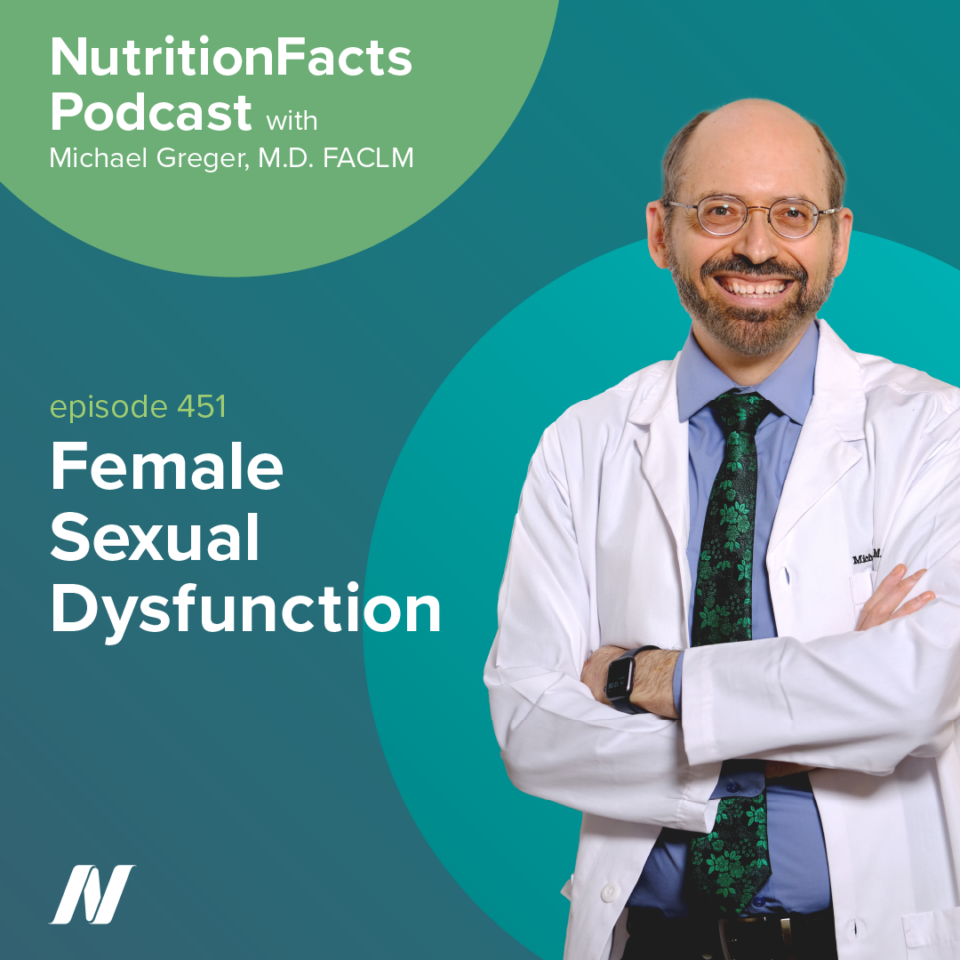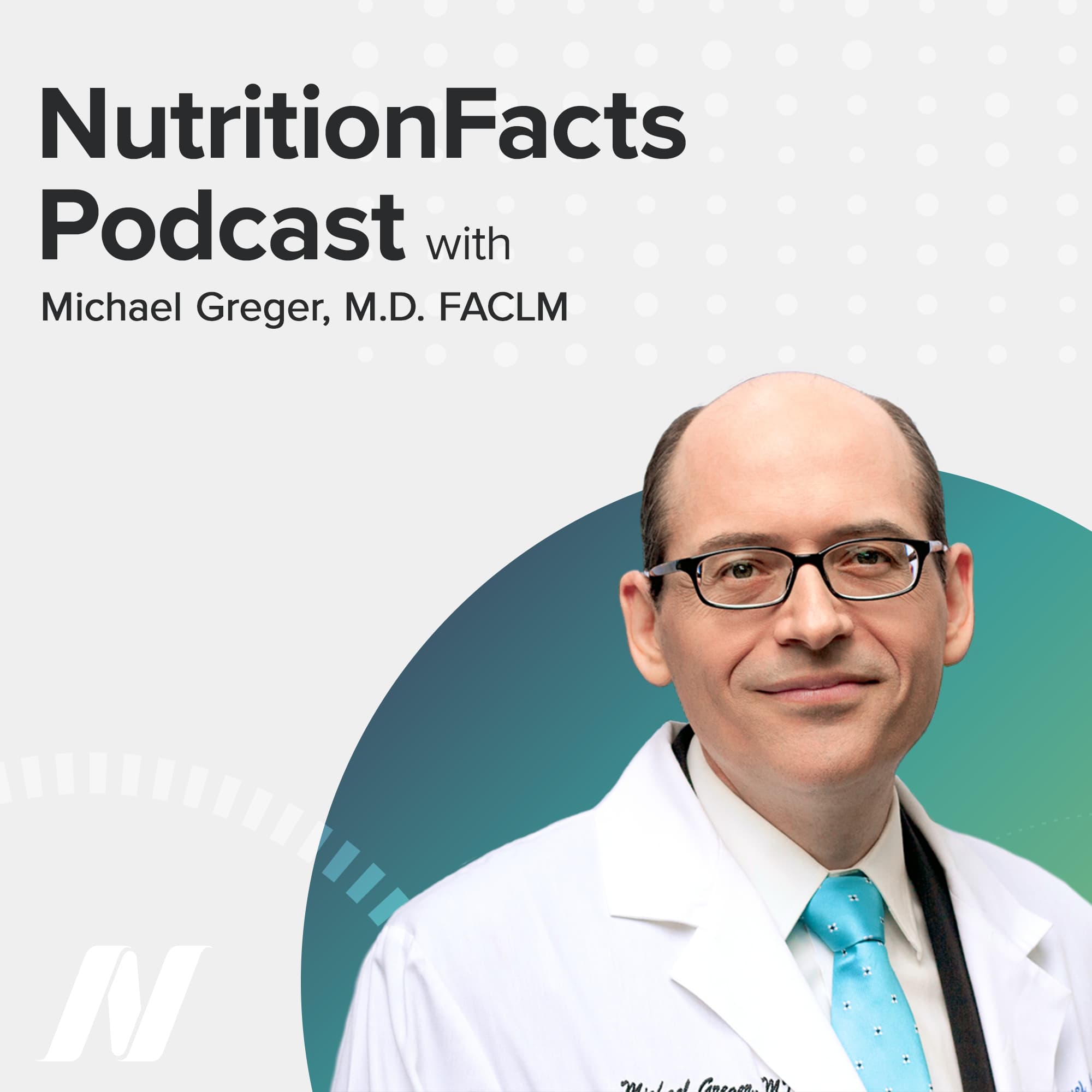DHEA supplements don’t seem to help with female sexual dysfunction, but what about other dietary supplements, such as the three roots: ginseng, maca, and ashwagandha? Ginseng has been suggested, given its demonstrated efficacy for male erectile dysfunction and the fact that it causes a relaxation response in vitro to isolated strips of rabbit vaginal tissue. But when put to the test in human studies, a meta-analysis found no statistically significant effect of ginseng on female sexual dysfunction.
Maca root has been advertised as Peruvian Viagra. It’s an important dietary staple of the indigenous people of Peru, but appears to have been overly hyped as a libido enhancer based largely on studies of male rodents. Yes, maca seems to enhance the sexual function of male mice and rats, but of the two trials on sexual desire in male humans, only one showed a significant benefit. But it took eight weeks to show an effect, which may explain the negative results of the second study, which only lasted two weeks. A pilot study without a placebo control on the management of sexual dysfunction induced by SSRIs (due to drugs like Prozac or Zoloft) on mostly women suggested maca may be useful. But when properly put to the test in a randomized, double-blind, placebo-controlled trial, it failed to have a significant effect. The necessity of placebos is illustrated by a maca trial for infertility. Maca increased sperm concentration by 40 percent! Yeah, but the placebo in the study improved sperm concentration by 76 percent; so, maca didn’t work after all.
Having placebo controls is particularly important for female sexual dysfunction, since based on studies of almost 4,000 women, the placebo effect accounts for more than two-thirds of the treatment effect, similar to the placebo efficacy of antidepressants. In contrast, improvement rates for erectile dysfunction in men given placebos are on the order of 15 percent or less. The thought is that just the act of consistent self-monitoring in female sexual dysfunction trials, for example, by being asked to keep a symptom diary, may improve symptoms by heightening the participant’s attention and awareness of her own responses and behaviors, even in lieu of an active treatment.
There was one small randomized, double-blind, placebo-controlled trial of maca for sexual dysfunction in postmenopausal women. Fourteen women were randomized to about 3/4 of a teaspoon (~4 g) of maca powder or a placebo powder every day for six weeks, after which point they switched for another six weeks. While on the real maca, they reported significantly fewer symptoms of sexual dysfunction.
Ashwagandha is a revered herb of the traditional Indian Ayurvedic system of medicine. Its name comes from “ashwa” which means horse, and “gandha” which means smell, because the roots evidently possess the “distinctive smell of a wet horse.” Ashwagandha is used as a household remedy in India, where it’s been considered a rasayana—“rejuvenator” or “tonic”—for thousands of years, earning it the nickname of Indian ginseng.
After being fed the root, rodents thrown into the deep end swim twice as long before sinking (12 hours versus six hours). Benefits for physical performance (including an increase in aerobic fitness) have been found in people too. One study demonstrated evidence of cognitive benefits as well. Its Latin name, Withania somnifera, points to another use (somnifera means “sleep-inducer”). A meta-analysis of five randomized controlled trials of ashwagandha extracts found a small but significant effect on overall sleep.
What about ashwagandha and female sexual function? Women ages 21 through 50 were randomized to two months of the estimated equivalent of three grams of ashwagandha root powder. And they did not have an increase in sexual desire, but they did show improvements over placebo in arousal, lubrication, orgasm, and satisfaction, translating into an additional quote-unquote “successful sexual encounter” by the end of the study. What are the downsides?
Ashwagandha belongs to the nightshade family, which includes some shady characters like tobacco and, well, deadly nightshade. There have been rare cases of ashwagandha-linked liver toxicity reported, though commercial herbal supplements are often mislabeled; so, it’s hard to definitively attribute certain cases. However, there have been several liver injury cases in which the supplements have been tested and found to be contaminant-free––suggesting that ashwagandha-induced liver toxicity is a real phenomenon, however rare. What should we expect from a plant known by its other nickname, poison gooseberry?
Did you know that the buildup of cholesterol in pelvic arteries can lead to sexual problems among both men and women via a similar pathway? Here’s the story.
Cholesterol doesn’t just build up inside our coronary arteries; it builds up inside all of our arteries. In the heart, it can cause a heart attack. In the brain, it can cause a stroke. In our legs, it can cause peripheral vascular disease. And clogs in our pelvic arteries can lead to sexual dysfunction—and not just in men.
“Hyperlipidemia and sexual function in premenopausal women.” Those with high cholesterol “reported significantly lower arousal, orgasm, lubrication, and satisfaction. Atherosclerosis of the arterial bed supplying the female pelvic anatomy can lead to decreased vaginal engorgement and clitoral erectile insufficiency syndrome, similar to erectile problems in men, resulting in vasculogenic female sexual dysfunction,” an important factor of which may be failure to achieve “clitoral tumescence,” or engorgement.
Eating healthier can extend one’s life, and also one’s love life.
In our final story today, we look at dietary approaches for female sexual dysfunction.
“The creation and promotion of ‘female sexual dysfunction’” as a mental disorder seems like “a textbook case of disease mongering by the pharmaceutical industry” harkening back to the first DSM, psychiatry’s diagnosis manual, which listed “frigidity” as a mental disorder, along, of course, with homosexuality. The latest manifestation is “hypoactive sexual desire disorder,” a disease invented by drug companies. It’s like when Prozac was about to go off patent, “the company sponsored the creation of” a new mental illness to market a drug called Sarafem, which was simply Prozac repacked into a pink capsule. “The condition previously known as shyness was…branded as ‘social anxiety disorder’” so they could get kids on Paxil.
“There are certainly women who are troubled by low libido, but there is no reliable scientific evidence that hypoactive sexual desire disorder is a real medical condition.” And, women can get diagnosed with it even with a normal libido. “A woman highly interested in sex, just not [for whatever reason this study,] with her current partner, can still qualify for [the] diagnosis”—and the drug. Even a woman who is perfectly satisfied with her sex life “may still qualify if her partner [isn’t].”
Our story begins in 2009, when a drug company tried to get “a failed antidepressant” called flibanserin approved “to treat hypoactive sexual desire disorder.” Only problem? It didn’t work. It was resubmitted again after more study, and was still rejected, as was the appeal. But, in 2015, the FDA approved the drug. “What changed? Nothing about [its] efficacy.” It didn’t work any better. What changed is that the drug company that bought it “helped launch an [astroturf fake grassroots] advocacy group, “Even the Score,” which lobbied for approval under a feminist rubric.
“Men have their drugs.” Why don’t women get any sex drugs, which was exposed as kind of a bitter irony. But hey, “within 48 hours of FDA approval, [the drug] was sold for [a cool] billion in cash. Very satisfying for the drug company, “but what about the women who take” the drug (sold now as Addyi)? Not much. The drug just doesn’t work as advertised.
Yes, it may stimulate monkeys to groom each other more. But, when researchers dug up the unpublished data about the drug, any clinical benefit was found to be “marginal,” and the drug was found to have significant adverse side effects. “Besides being ineffective…, [it can be] dangerous.” “[C]ombining [it] with alcohol can cause dangerous hypotension and [fainting]—problems so serious that the FDA put a black box warning on it, its most serious safety alert, on the label [that, of course, no one reads].” “Even without alcohol, [it] can cause severe drops in blood pressure levels and [cause] sudden prolonged unconsciousness. Now, serious side effects “might be acceptable in [some kind of] cancer [wonder] drug or something, but “are entirely unacceptable in a drug given to healthy women for an invented condition.”
Are there any safe and natural solutions? Well, there’s lots of studies on diet and men’s sexual health, but what about women’s? I’ve previously explored the evidence about women with high cholesterol levels reporting diminished sexual function across a number of dimensions. This could explain why a more plant-based diet, rich in a variety of whole plant foods, “might be effective in ameliorating sexual function [issues] in women,” as it does in men. More whole grains, beans, vegetables, and fruit, and less meat, dairy, and sugar “associated with a reduced risk of [erectile dysfunction],” because the anatomy and physiology of sexual responses are actually quite similar between the two, they have a similar effect. You can measure clitoral engorgement with fancy MRI techniques within minutes of exposure to an erotic video.
And, we now know lubrication is all about blood flow, too. “Within the sexually-aroused vagina,” it’s the hydrostatic pressure from all the additional pelvic blood flow that forces fluid “to leak [out] onto the surface…as the vaginal lubrication.”
So, how can we improve blood flow? Well, the flavonoid phytonutrients in cocoa can help open up arteries, increasing pulse wave amplitude, peaking at about 90 minutes after consumption.
So, can that Valentine’s Day chocolate make a difference? Women who eat chocolate do tend to have higher female sexual function index scores, but the effect disappeared once age was taken into account. So: “Despite all the potential biological mechanisms supporting a role for chocolate as an aphrodisiac food,” the study failed to show a benefit. One would assume that chocolate could improve blood flow, but remember that was with cocoa powder. Maybe the fat and sugar in chocolate is counteracting the benefits. What are some whole-food sources of flavonoids? Well, onions have a lot. Indeed, “fresh onion juice enhanced copulatory behavior…in…rats,” but for those of us less interested in increasing “the percentage of ejaculating rats,” and looking for something other than onion juice for our hot date, how about that apple?
But, “there [wasn’t] a study addressing the potential correlation between daily apple consumption and women’s sexual function”…until, now. The title kind of gives it away, but women were split into regular daily apple consumers versus those consuming less than an apple a day, and the hundreds of apple eaters in the study scored “significantly higher” on the female sexual function index.
Now, note they only included women eating unpeeled apples, because the phytonutrients are concentrated in the peel. So, we don’t know if there’s a link with peeled apples. And, this was just an observational study; so, “further studies will be necessary to clarify…the relationship between apple intake
and female sexuality.” “However, the present data can allow the development of future research for identifying new compounds and food supplements to use in female sexuality recovery.” Uh, or, you can just try eating an apple.

 Previous Podcast
Previous Podcast Next Podcast
Next Podcast